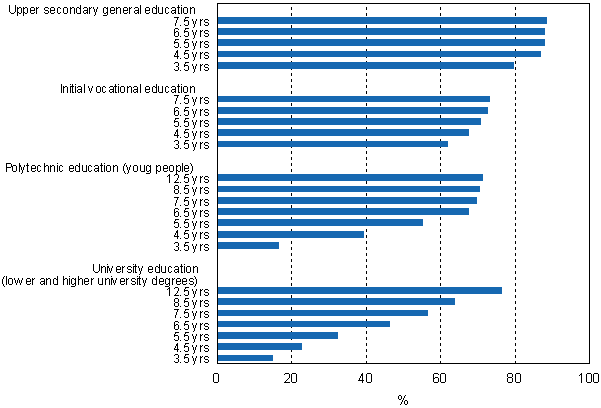Published: 15 May 2009
Matriculation examination attained by nearly 90 per cent and vocational qualification or tertiary degree attained by over 70 per cent of students who start studies
According to Statistics Finland, nearly 90 per cent of the students who started upper secondary general school in 2001 had attained a matriculation examination by the end of 2007. During the same period, 73 per cent of the students in vocational education attained a vocational qualification. By the end of 2007, polytechnic degrees were attained by 71 per cent of the students who entered polytechnic education twelve-and-a-half years ago. During the same period, 77 per cent of the new students at universities attained a lower or higher university degree.
In a short-term examination the pass rate in different sectors shows more variation. In three-and-a-half years the pass rate of a matriculation examination was close to 80 per cent and that of an initial vocational qualification was 62 per cent. In four-and-a-half years polytechnic education aimed at young people was passed by 40 per cent of the new students. New students' pass rate of a university degree in five-and-a-half years was 33 per cent.
In vocational education the highest pass rates after three-and-a-half years from the start of studies were in the fields of the humanities and education as well as in welfare, health and sports, where a qualification had been attained by 67 per cent of students. The lowest pass rate, at 49 per cent, was in the field of natural sciences. Among the students who started polytechnic studies in 2003, the highest pass rate after four-and-a-half years was in the field of welfare, health and sports, where it stood at 65 per cent. The lowest pass rate, at 20 per cent, was in the field of technology and transport. Of the students who started their studies in 2002, relatively the highest numbers of higher university degrees were attained by the end of 2007 by students in the fields of social sciences, economics and administration, while relatively the lowest number of degrees were attained by students of technology and transport.
In all sectors of education men's pass rate is lower than that of women. In upper secondary general and initial vocational education men's pass rate is only a few percentage points lower than that of women, whereas the difference is much bigger in university level degrees. Twelve-and-a-half years after starting studies 64 per cent of men had attained a polytechnic qualification, while the corresponding percentage for women was 78 per cent. A higher or lower university degree was attained in twelve-and-a-half years by 69 per cent of men and 83 per cent of women.
Pass rate by educational sector in different reference periods by the end of 2007

Source: Education Statistics. Statistics Finland
Inquiries: Ms Annika Latva-Äijö +358 9 1734 3273, koulutustilastot@stat.fi
Director in charge: Mr Jari Tarkoma
- Tables
-
Tables in databases
Pick the data you need into tables, view the data as graphs, or download the data for your use.
Last updated 15.5.2009
Official Statistics of Finland (OSF):
Progress of studies [e-publication].
ISSN=1799-1021. 2007. Helsinki: Statistics Finland [referred: 21.12.2025].
Access method: http://stat.fi/til/opku/2007/opku_2007_2009-05-15_tie_001_en.html

